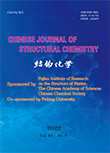Syntheses, Crystal Structures and DNA-Binding Properties of Zn(II) and Mn(II) Complexes Based on Imidazole Derivatives and Carboxylic Acid
GUAN Hui-Chao, SONG Xiao-Tong, LIU Gui-Bao and YUE Shu-Mei*
Chin. J. Struct. Chem. 2022, 41, 2203260-2203269 DOI: 10.14102/j.cnki.0254-5861.2011-3363
March 15, 2022
single-crystal structures, spectroscopy, CT-DNA binding, 2-(2-pyridyl)benzimidazole
ABSTRACT
Complexes [Zn(pbm)(5-hip)3] (1),
[Zn(pbm)(5-nip)3] (2), [Mn(pbm)(H3btc)2(H2O)]
(3) and [Mn(pbm)(5-nip)3] (4), where H2HIPA
= 5-hydroxyisophthalic acid, H2nip = 5-nitroisophthalic acid, H3btc
= trimesic acid and pbm (pyridine benzene chelate material) = 2-(2-pyridyl)benzimidazole,
were identified via single-crystal XRD analyses. 1, 2 and 4 pertain to the monoclinic space group C2/c, while 3 belongs to
the triclinic space group P. The
interplay of CT-DNA with those complexes was delineated using ultraviolet,
fluorescence, and circular dichroism (CD) spectroscopy and viscosity
measurements. Complexes 1, 2, 3 and 4 interact with CT-DNA in an electrostatic or grooving mode. We
wish to offer a theory-wise foundation for developing anti-tumor medicines.








